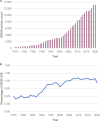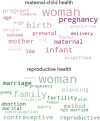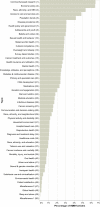Mining the health disparities and minority health bibliome: A computational scoping review and gap analysis of 200,000+ articles
- PMID: 38266089
- PMCID: PMC10807818
- DOI: 10.1126/sciadv.adf9033
Mining the health disparities and minority health bibliome: A computational scoping review and gap analysis of 200,000+ articles
Abstract
Without comprehensive examination of available literature on health disparities and minority health (HDMH), the field is left vulnerable to disproportionately focus on specific populations or conditions, curtailing our ability to fully advance health equity. Using scalable open-source methods, we conducted a computational scoping review of more than 200,000 articles to investigate major populations, conditions, and themes as well as notable gaps. We also compared trends in studied conditions to their relative prevalence using insurance claims (42 million Americans). HDMH publications represent 1% of articles in Medical Literature Analysis and Retrieval System Online (MEDLINE). Most studies are observational in nature, although randomized trial reporting has increased fivefold in the past 20 years. Half of HDMH articles concentrate on only three disease groups (cancer, mental health, and endocrine/metabolic disorders), while hearing, vision, and skin-related conditions are among the least well represented despite substantial prevalence. To support further investigation, we present HDMH Monitor, an interactive dashboard and repository generated from the HDMH bibliome.
Figures






Update of
-
Mining the Health Disparities and Minority Health Bibliome: A Computational Scoping Review and Gap Analysis of 200,000+ Articles.medRxiv [Preprint]. 2023 Oct 17:2023.10.17.23296754. doi: 10.1101/2023.10.17.23296754. medRxiv. 2023. Update in: Sci Adv. 2024 Jan 26;10(4):eadf9033. doi: 10.1126/sciadv.adf9033. PMID: 37905137 Free PMC article. Updated. Preprint.
Similar articles
-
Mining the Health Disparities and Minority Health Bibliome: A Computational Scoping Review and Gap Analysis of 200,000+ Articles.medRxiv [Preprint]. 2023 Oct 17:2023.10.17.23296754. doi: 10.1101/2023.10.17.23296754. medRxiv. 2023. Update in: Sci Adv. 2024 Jan 26;10(4):eadf9033. doi: 10.1126/sciadv.adf9033. PMID: 37905137 Free PMC article. Updated. Preprint.
-
Folic acid supplementation and malaria susceptibility and severity among people taking antifolate antimalarial drugs in endemic areas.Cochrane Database Syst Rev. 2022 Feb 1;2(2022):CD014217. doi: 10.1002/14651858.CD014217. Cochrane Database Syst Rev. 2022. PMID: 36321557 Free PMC article.
-
The 2023 Latin America report of the Lancet Countdown on health and climate change: the imperative for health-centred climate-resilient development.Lancet Reg Health Am. 2024 Apr 23;33:100746. doi: 10.1016/j.lana.2024.100746. eCollection 2024 May. Lancet Reg Health Am. 2024. PMID: 38800647 Free PMC article. Review.
-
Inequities and Research Gaps in Ophthalmology: A Scoping Review.JAMA Ophthalmol. 2023 Jan 1;141(1):63-70. doi: 10.1001/jamaophthalmol.2022.5237. JAMA Ophthalmol. 2023. PMID: 36480183 Free PMC article.
-
Eating disorders in minority ethnic populations in Australia, Canada, Aotearoa New Zealand and the UK: a scoping review.J Eat Disord. 2025 Jan 14;13(1):8. doi: 10.1186/s40337-024-01173-y. J Eat Disord. 2025. PMID: 39810222 Free PMC article. Review.
References
-
- United States Department of Health and Human Services. Task Force on Black and Minority Health., “Report of the Secretary’s Task Force on Black and Minority Health” (U.S. Department of Health and Human Services, 1985).
-
- Institute of Medicine (US) Committee on Understanding and Eliminating Racial and Ethnic Disparities in Health Care, Unequal Treatment: Confronting Racial and Ethnic Disparities in Health Care (National Academies Press, 2003); www.ncbi.nlm.nih.gov/books/NBK220358/. - PubMed
-
- Agency for Healthcare Research and Quality, “2021 National Healthcare Quality and Disparities Report” (Agency for Healthcare Research and Quality, 2021); www.ahrq.gov/research/findings/nhqrdr/nhqdr21/index.html.
Publication types
MeSH terms
Grants and funding
LinkOut - more resources
Full Text Sources
Other Literature Sources
Miscellaneous

